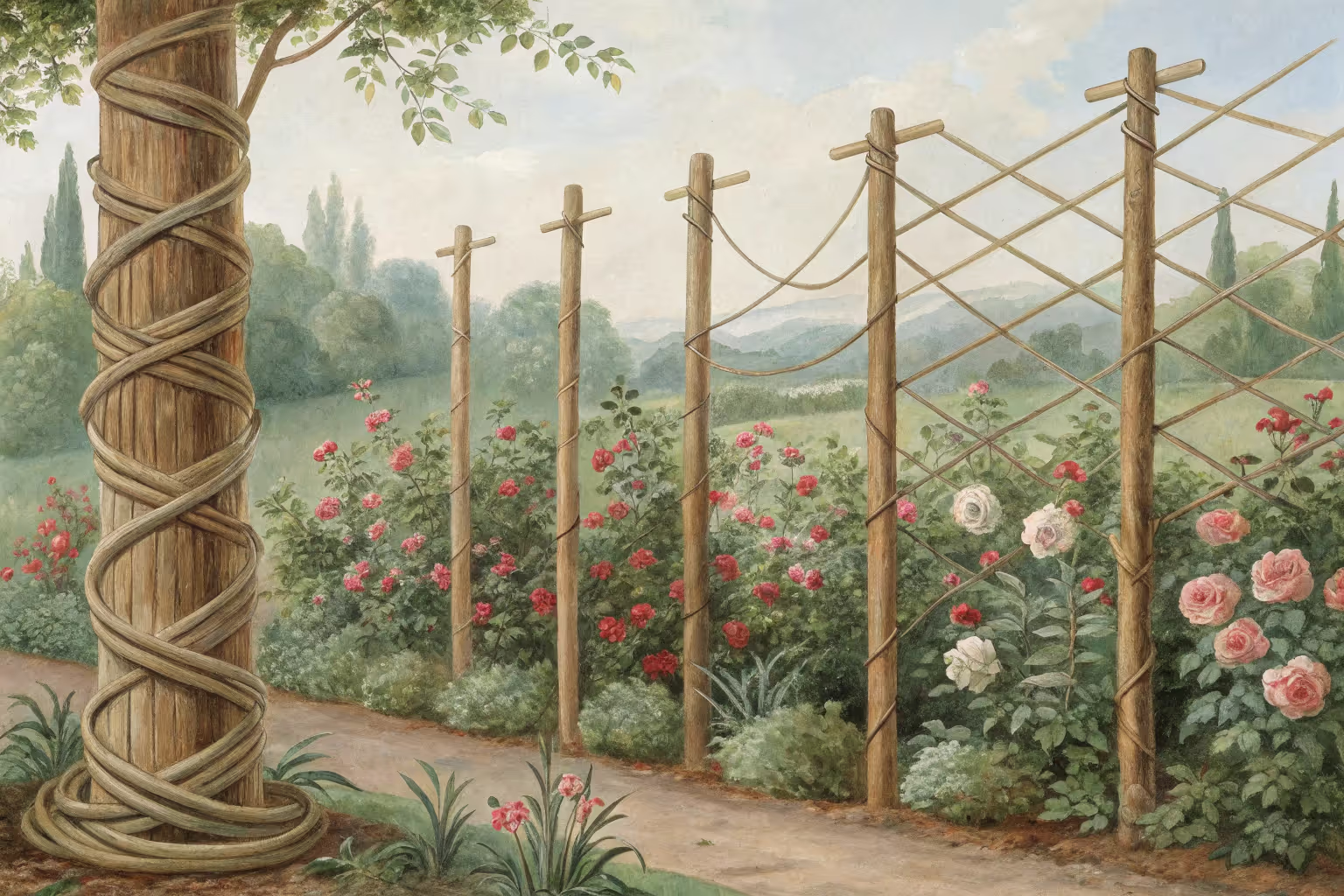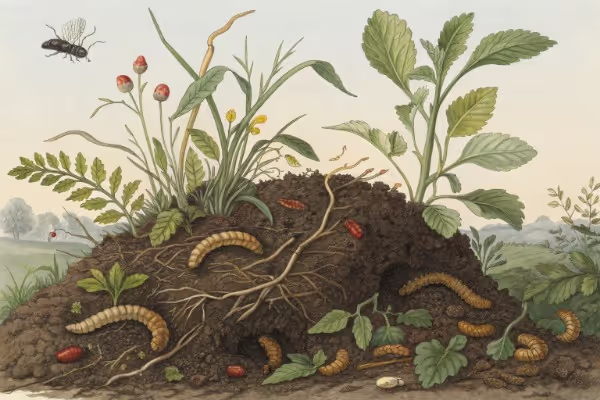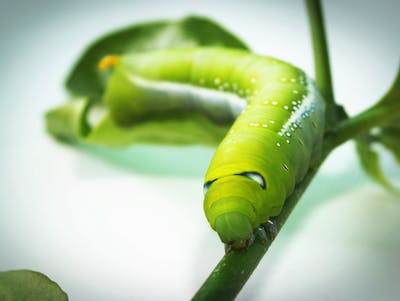Unexpected Uses for Garden Twine and Stakes: Enhance Your Garden Effortlessly

Garden twine and stakes
Grab garden twine and stakes to craft vertical gardens, support unruly tomatoes, or shape climbing roses. Use garden twine and stakes to effortlessly design raised-bed grids or bind herb bunches for drying. Simple, versatile, and compostable, garden twine and stakes transform everyday gardening chores into satisfying creative projects—read on to uncover unexpected methods that'll simplify your time outdoors and boost your harvest.
Cheatsheet: Garden Twine & Stakes Hacks
🛠 Tools and Products You'll Need
- Natural fiber or jute twine
- Bamboo or wood stakes (3-6 ft / 1-2 m)
- Garden scissors or pruners
- Measuring tape
- Optional: twist ties, colored string
🌱 Vertical Growing Systems
- Triple plant yields by string trellising tomatoes, peas, or beans. Space twine between stakes for easy climbing.
- Save ground space: 1 sq ft (0.09 sqm) = 12 pole beans vertically.
🌻 Row Markers & Spacing Aids
- Stretch twine tightly between stakes to guide straight seed rows.
- Avoid root crowding: Mark 12 in (30 cm) spacing for squash, 10 in (25 cm) for carrots.
🌿 DIY Bug Barriers & Netting Frames
- Form frames with stakes + twine, drape row cover over for instant pest control.
- Reduce pesticide use: Physical barriers can cut infestations by 80%.
🌸 Flower Supports & Shape Training
- Loop twine in a spiral or grid for dahlias, peonies, sunflowers. Prevent snapping.
- Create circular patterns for sculpted herb or flower beds.
🍏 Espalier & Vertical Fruits
- Guide apple or pear branches along twine lines for espalier walls.
- Improves sun exposure and boosts fruit yield by up to 60%.
🥬 Harvest & Crop Storage Aids
- Bundle and hang garlic, onions, or herbs from stakes with twine for curing.
- Supports optimal drying: reduces spoilage, increases storage life.
🌾 Wildlife & Pet Deterrents
- Create a low twine fence (12 in / 30 cm high) to keep out rabbits or cats.
- Add fluttering tape or reflective string for more deterrent power.
💡 Quick Project Steps
- Measure area, mark stake positions.
- Drive stakes firmly (base 6-8 in / 15-20 cm deep).
- Tie twine securely—double knots for tension jobs.
- Add extra rows or diagonals as needed (for grid or netting).
- Use scissors to trim excess twine for tidy results.
I keep a spool of Garden twine and stakes in my apron the way a chef keeps salt. Small tools, huge impact.
Once a windstorm snapped half my tomatoes at the collar, and a simple stake-and-weave fixed the chaos overnight.
For peas and pole beans, lash two bamboo stakes into an A-frame, run twine ladders every 6 inches 15 cm, and watch vines climb like alpinists. It sets up in five minutes, tears down in two.
Cucumbers behave on a diagonal trellis: drive stakes at 60 degrees, tie three tensioned twine rails, and keep fruit clean and straight. Fewer bites from slugs, cleaner skins, easier harvest.
Tomatoes love the Florida Weave on 6 to 8 foot 1.8 to 2.4 m stakes with twine bands every 8 to 10 inches 20 to 25 cm. Cornell Cooperative Extension calls it efficient for determinate varieties and tidy for small acreage.
Espalier without fancy gear: string twine on screw eyes between two sturdy stakes and train figs, apples, or blackberries along horizontal lines. I adjust ties weekly and keep airflow high, which trims disease pressure.
“Stake young trees low and tie them loosely so the stem can flex and thicken. Fix the tie about one-third up the trunk.” — Royal Horticultural Society, Tree staking and guying
Use a figure-eight tie around the stem with a buffer loop to prevent girdling. Jute grips bark, cotton cushions, and soft rubber-coated wire handles heavier stems without scarring.
For heavy clusters, throw a clove hitch on the stake, then a loose half-hitch on the stem. It bites the post, not the plant.
Twine tension sags in heat, so twist a short stick into the line as a windlass and tuck it behind the stake. A two-second fix saves a season of slouching vines.
Make a ridge line between stakes and drape floating row cover for spring greens. University of Minnesota Extension notes light covers can add about 2 to 4 F 1 to 2 C of frost protection.
In heat waves, tie 30 to 50 percent shade cloth for peppers and lettuce. UC ANR recommends those ranges to reduce sunscald while keeping photosynthesis humming.
For wind, staple burlap to stakes on the windward side of beds at 3 to 4 feet 0.9 to 1.2 m. Plants settle down, transpiration steadies, and you water less.
Pin drip lines to stakes with twine ties every 18 inches 45 cm to stop the “wandering snake” problem. Emitters hit the root zone instead of the path.
Hang a cheap line level on a taut twine run between two stakes to set grade for rills or French drains. Your mulch stops floating, and the bed drains evenly after gully washers.
Square-foot grid in minutes: stake four corners, twine 12 by 12 inch 30 by 30 cm squares, and plant on intersections. Even kids hit perfect spacing every time.
I color-code crop rows with dyed twine in spring, then switch to natural jute as canopy closes. Labels stay readable and harvest stays sane.
String a temporary deer line with tall stakes and two twine tiers at 4 and 8 feet 1.2 and 2.4 m with flagging every 18 inches 45 cm. Penn State Extension recommends 8 feet 2.4 m to reliably deter deer.
For brassicas, build a stake cube and zip fine mesh to the twine frame. Cabbage white butterflies lose the invitation and you skip a spray cycle.
Bird pecks in strawberries drop when I add crisscross twine 12 inches 30 cm above the bed with a few reflective ribbons. The canopy spooks them without blocking bees.
Run a high twine line under a porch and clip bunches of sage, oregano, and thyme. The National Center for Home Food Preservation suggests drying herbs in warm, ventilated spaces around 70 to 90 F 21 to 32 C.
Bulb onions cure clean if you weave their necks over a taut line for two weeks. Good airflow keeps neck rot at bay and skins firm up like parchment.
Wrap a three-stake triangle with twine spirals to make a compost corral. Feed it weekly and unwind a panel for turning.
For straw-bale gardens, stakes stop bales from yawning after saturation. Then twine a perimeter to keep soil and compost in place on top.
- Jute twine: biodegradable, grippy, good for single-season ties. Replace yearly in wet climates.
- Sisal twine: stronger than jute and more water tolerant. Great for Florida Weave and cucumbers.
- Cotton butcher’s twine: gentle on stems, easy knots. Can wick moisture, so watch for rot on thick ties.
- Coir twine: durable and natural. Nice for long trellises and hops.
- UV-stabilized synthetic twine: lasts multiple seasons. Use where you will remove ties from plants after harvest.
- Rubber-coated wire ties: reusable and soft. My pick for fruit trees and peppers with heavy loads.
- Bamboo stakes: light, affordable, and renewable. Soak tips in linseed oil for longer life.
- Hardwood or cedar stakes: sturdy with good soil bite. Look for FSC-certified wood.
- Fiberglass stakes: springy and long-lived. Excellent for windy sites and repeated Florida Weave.
- Metal T-posts: heavy duty and reusable. Use post caps and cushion ties to protect stems.
- Recycled-plastic stakes: rot-proof and consistent diameter. Good where termites or constant moisture chew up wood.
- Tomatoes over 5 feet 1.5 m: fiberglass stakes with sisal or UV twine in a weave. I tighten bands after storms.
- Peas and beans: bamboo A-frames with jute ladders. Quick to store and compost the twine after harvest.
- Peppers and eggplant: hardwood stakes with soft rubber ties. Gentle support for brittle stems.
- Cucumbers and melons: angled cedar with sisal rails. Fruit hangs clean and shapes evenly.
- Young trees: low single stake and a wide soft tie. Per RHS, keep the tie loose and low so the trunk builds strength.
Match tie width to stem thickness, and never cinch tighter than a pencil sliding through. Inspect monthly and cut away anything that bites.
Drive stakes below the root flare on trees and outside root balls on transplants. Keep ties at least 2 inches 5 cm away from the stem with a buffer loop.
Replace natural twine each season in rain-prone zones. Sun and microbes happily recycle it into the soil.
Before high winds, I add a midline twine wrap to tomato rows and a top rail to trellises. After, I retension everything and prune to restore balance.
I learned to tie off on the windward stake, then finish on the leeward side. Lines stay taut and posts stay plumb.
Jute or sisal rolls often run 3 to 10 USD 3 to 9 EUR per 325 feet 100 m. Rubber-coated ties cost more upfront but last many seasons.
Bamboo stakes come in bundles and start around 10 to 25 USD 9 to 23 EUR for ten 4-footers. Fiberglass or T-posts range 3 to 12 USD 3 to 11 EUR each depending on length and gauge.
Check farm-supply stores for bulk twine and sturdy posts. Arborist suppliers carry wide soft ties and proper tree staking kits that pay for themselves in saved replacements.
“Lightweight row covers increase earliness and can improve yields while excluding insect pests.” — University of Minnesota Extension
- Figure-eight tie: protects stems by keeping the knot off bark.
- Clove hitch: fast, adjustable, and grips stakes securely.
- Constrictor knot: for non-living structures when you need a set-and-forget bind.
- Slip knot: quick-release for harvest days and winter teardown.
Walk the lines weekly, retension sags, and snip any tie that marks bark. After harvest, wash and coil synthetics, compost plant-safe naturals.
I tag coils with masking tape that lists length and material. Next season starts organized and fast.
Make a low bee corridor by staking a zigzag line and clipping annuals like calendula and phacelia along it. Pollinators find the runway and yields jump.
Build a pea-shooter of a pea tunnel for kids with two rows of stakes and a twine arch. They will pick more peas than you planted.

Want smarter plant choices? 🪴
Frequently Asked Questions: Garden Twine and Stakes
How can garden twine and stakes improve plant growth?
Garden twine and stakes guide vines and stems upward, preventing entanglement and decay by promoting airflow and sun exposure. Think of stakes as dependable bartenders, supporting each plant's posture, while twine gracefully nudges growth toward light.
What unconventional roles can garden twine play in pest control?
Twine acts as an effective deterrent when soaked lightly in essential oils like mint or citronella. Suspend this aromatic barrier among stakes to repel undesirable insects naturally, discouraging them from dining on your prized plants.
Can garden stakes and twine assist in creating unique plant structures?
Absolutely. With stakes and twine, gardeners craft trellises, pergolas, and privacy screens. Let the stakes anchor sturdy architecture while twine weaves inquisitively, forming spaces that intimately blend function and beauty.
What's an artful method for using stakes and twine to organize garden beds?
Arrange stakes strategically around beds, then stretch twine to outline planting sections or pathways. You'll define clear, intentional areas—instantly turning chaos into purposeful harmony, freeing your vegetation to thrive without interference.
Do garden twine and stakes have a role in composting?
Indeed. Stakes encircle compost heaps, containing organic matter neatly, while twine forms adjustable enclosures, easily opened and tightened. This simple system streamlines compost management, nurturing rich soil amendments to fuel your garden's appetite.
Garden twine and stakes—humble tools, but they’re the quiet backbone of a thriving plot. From propping up unruly tomatoes to guiding beans skyward, they keep things tidy and productive. But their value runs deeper: creative gardeners use them to mark rows, train vines, or even set up makeshift trellises in a pinch. The best gardens are shaped by simple solutions, and these two are as reliable as an old friend. Don’t overlook their versatility—sometimes the most straightforward tools make the biggest difference. For more ways to simplify your plot, check out these gardening classes or explore clever uses for everyday items like eggshells or citrus peels. In the end, a roll of twine and a handful of stakes are all you need to keep your garden running smooth—and maybe even surprise yourself with what you can grow.
Health Benefits of Using Garden Twine and Stakes
Improved Ergonomics and Injury Prevention
Securing plants with garden twine and stakes reduces bending and reaching, minimizing back strain and muscle fatigue. Properly supported plants allow gardeners to tend crops standing upright, decreasing repetitive stress injuries and increasing comfort.
Reduced Chemical Exposure
Regularly staking plants prevents foliage from touching the soil, lowering risks of fungal infections and pest infestations. This practice significantly reduces dependency on chemical fungicides and pesticides, minimizing chemical exposure.
Increased Nutritionally Dense Harvest
Staking plants enhances air circulation and sunlight exposure, promoting photosynthesis and nutrient absorption. Tomatoes staked upright show up to 20% higher lycopene content compared to unsupported varieties, improving nutritional quality.
Mental Health and Mindfulness
Regularly using twine and stakes fosters structured gardening tasks, encouraging mindfulness and reducing stress. Structured activities lower cortisol levels, enhance mood, and promote cognitive clarity.
Sustainable Gardening and Self-Sufficiency
- Use biodegradable twine (e.g., jute, sisal) for compostable plant waste, enriching soil naturally.
- Repurpose sturdy stakes seasonally for resource conservation and reduced garden waste.
- Maintain organized vertical gardening to maximize small-space yields, increasing food independence.
Find out which plants will thrive in your garden!
Answer a few fun questions and get custom plant recommendations perfect for your space. Let’s grow something amazing together!

start your season


.avif)


